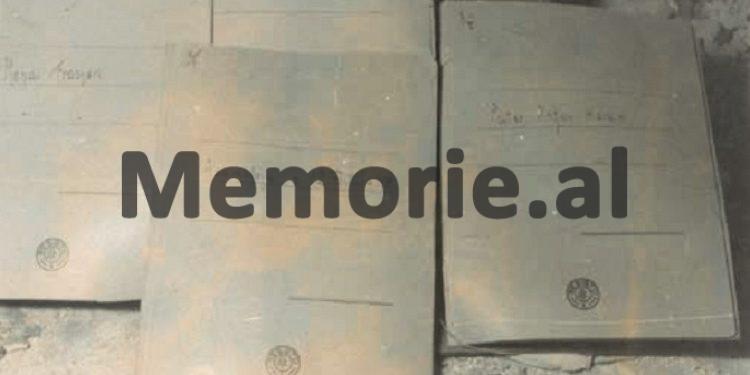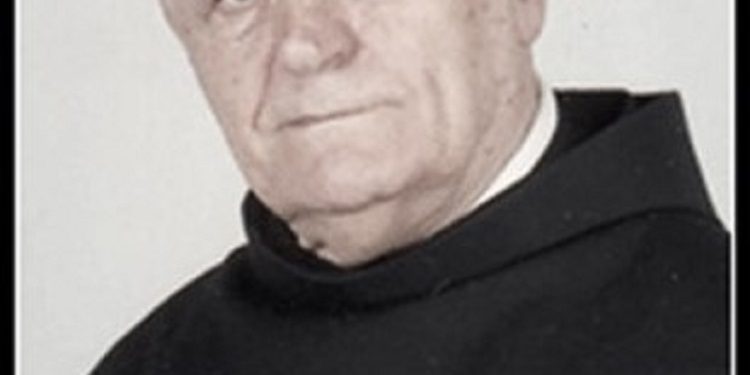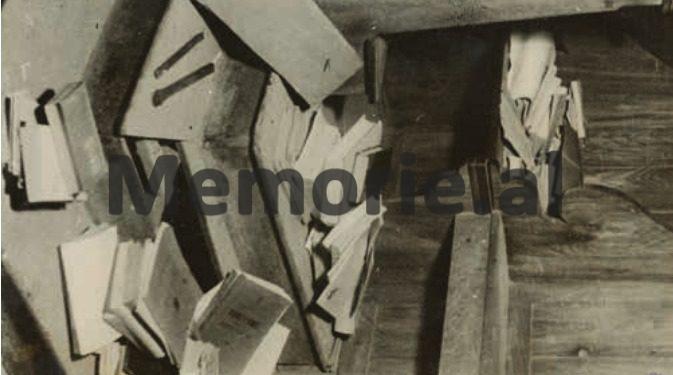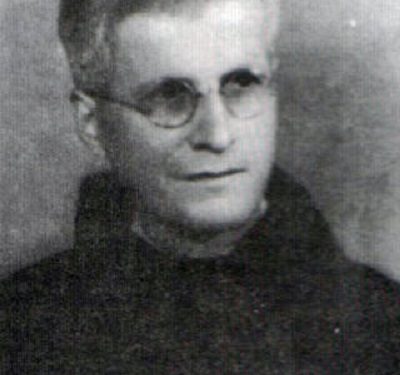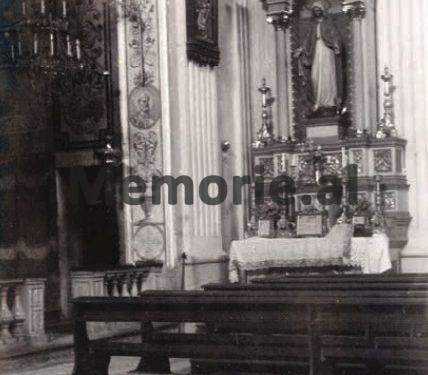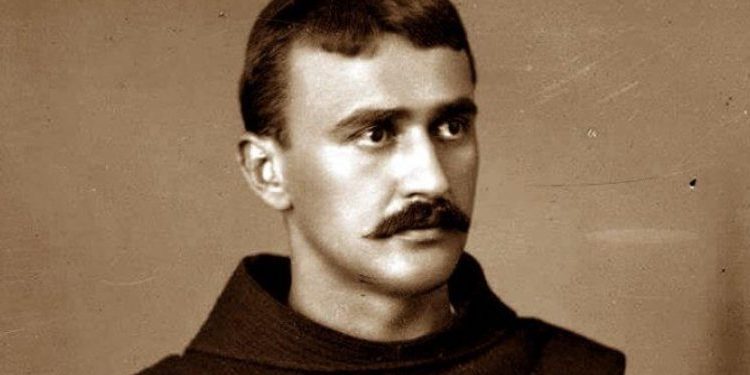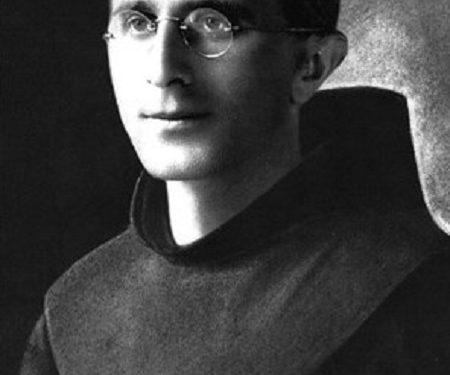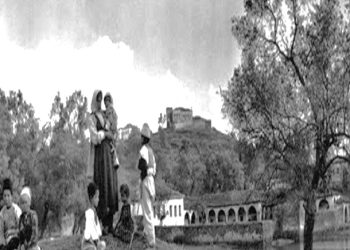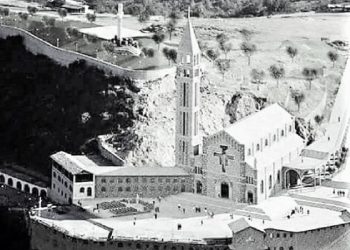By Dom Zef Simoni
The first part
Memorie.al publishes an unknown study by Dom Zef Simon, entitled “Persecution of the Catholic Church in Albania from 1944 to 1990”, where a Catholic cleric from the city of Shkodra who suffered for years in the prisons of the communist regime of Enver Hoxha and on April 25, 1993 he was ordained a Bishop by the head of the Holy See, Pope John Paul II, after describing a brief history of the Catholic Clergy in Albania, he stopped long at the persecution suffered by the Catholic Church in the regime communist, from 1944 to 1990. The complete study of Dom Zef Simon, starting from the attempts of the communist government of Tirana immediately after the end of the War to separate the Catholic Church from the Vatican, initially forbidding the Apostolic Delegate to return to Albania, Imzot Leone GB Nigris, after his visit to the Pope at the Vatican in 1945 and then with the pressure and threats against Monsignor Frano Gjini, Gaspër Thaçi and Vincens Prenushti, who strongly opposed the “offer” of Enver Hoxha and as a result were fired by him, as well as the tragic fate of many other clerics who were arrested, tortured and sentenced to imprisonment, such as: Dom Ndoc Nikaj, Dom Mikel Koliqi, Father Mark Harapi, Father Agustin Ashiku, Father Marjan Prela, Father Rrok Gurashi, Dom Jak Zekaj, Dom Nikollë Lasku, Dom Rrok Frisku, Dom Ndue Soku, Dom Vlash Muçaj, Dom Pal Gjini, Fra Zef Pllumi, Dom Zef Shtufi, Dom Prenkë Qefalija, Dom Nikoll Shelqeti, Dom Ndré Lufi, Dom Mark Bicaj, Dom Ndoc Sahatçija, Dom Ejëll Deda, Father Karlo Serreqi, Dom Tomë Laca, Dom Loro Nodaj, Dom Pashko Muzhani, etc.
Study of Dom Zef Simon
On August 16, 1944, on the occasion of the feast of Saint Rroku, which is specially celebrated in Shiroka, a village by the lake of Shkodra, in the procession of this day, Dom Ndre Zadeja, the priest of duty, the orator and the chosen writer, i fiery in the heart, and honor works for “Religion and Homeland”, a binomial that had characterized the Catholic Clergy historically, and especially in the times of the wars of Gjergj Kastriot-Skanderbeg, said these words to the people of youth: , especially with you, young man. A black cloud with a red ideology is coming over your heads. It intends to fall on you, but then you will have nothing to do with it, except with bytes and me try the evils, for besides the other blacks she has, she also denies the Lord. ” He said these words three and a half months before communism entered Albania, and almost seven months before the fiery priest, the valuable Dom Ndre Zadeja, was shot, the first priest shot in Shkodra, behind the wall of the Catholic cemetery, with March 25, 1945, a sunny day, an event that shook Shkodra, the districts, the highlands and all of Albania.
The Communists later learned that the midnight Christmas Mass on December 24, 1944 in the Cathedral Church would not be said to be a disturbance. But the new regime did not tolerate this action. Therefore, some Christian national liberators and some Christian communists, although later, around two o’clock in the afternoon, addressed the Archbishop of Shkodra, Monsignor Gaspër Thaçi, with a prayer to say the Midnight Mass. After the Monsignor told them: ‘it is too late to inform the people now’, they promised to undertake to inform him. They went from door to door saying, “Tonight is the Mass, and do not be afraid, for faith is free.” Moreover, if anyone said that the faith would not be free, this would be called by the new regime a slander, a strong slogan of reaction, and there would be punishments. Shej sure that there would be no trick became the rams of the kumbons throughout the city of a great people participated quietly and with much joy in the Midnight Mass.
But the new regime could not endure long, could not stand without its own lies and without liars in everything.
The persecution began quickly, a special persecution in the world and in the history of our nation, a fanatical and continuous fifty-year massacre, to destroy everything of value that was achieved especially after independence. The struggle against the Church of the Catholic faith at this time can be divided into three stages:
The first, starts from 1945 to 1950. It is the disappearance of the clergy, with imprisonments and shootings, after severely inhuman tortures, the disappearance of Catholic spiritual and cultural values throughout Albania, under the leadership of the Communist Party, led by Enver Hoxha, relies on Slavic politics directly in Albania, led by Tito.
The second phase, starting from 1951 to 1960, is what we are calling a kind of easing of the intensification of the fight against religion, after the breakdown of relations with Yugoslavia.
The third, after the break-up of the Soviet Union in 1961, but kept the Stalinist line, that of the Chinese period, when Chinese pressures will resemble, the closure of churches and all religious institutions in Albania, with the cultural revolution, until 1990.
Albania, ecclesiastically had five dioceses and the Nullius Abbey of Mirdita.
It was the archdiocese of Shkodra, a metropolitan center headed by its archbishop, Monsignor Gaspër Thaçi, the Archbishopric of Durrës with the archbishop Monsignor Vinçenc Prennushi, who was also the Administrator of Southern Albania, Monsignor Gjergj Volaj, bishop Le Bishop’s diocese Monsignor Luigj Bumçi, Bishop of Pulti with Monsignor Bernardin Shllaku, Abacia Nullius of Mirdita, based in Orosh with Bishop Monsignor Frano Gjini and the Apostolic Delegate, based in Shkodra, Monsignor Leone Nigris.
There were some orders of religious men and women in Albania. The order of St. Francis with the provincial in Shkodra, the early order since the XIII century, which, according to tradition, with the arrival of St. Francis in Lezha. An order that held the mission even in the most difficult areas of Dukagjini. Lavroi spoke the Albanian language and opened a kind of high school in Pëdhana e Zejmenit, in the seventeenth century, two more schools, that of Troshan and Blinisht. In the city of Shkodra, barefoot, with sandals, opened the first public primary school in Albania, for the poor, in 1861.
Later, the poor of Assis also opened the high school “Illyricum” of a high level, with students from all over Albania and for Christians and Muslims. An order that gave outstanding figures of knowledge in all fields such as linguists, writers, eminent professors of classical Greco-Roman culture, historians such as: Mons. Vinçenc Prennushi, Father Anton Harapi, Father Gjergj Fishta, Father Justin Rrota, Father Marin Sirdani, Father Pashko Bardhi, Father Bernardin Pali, Father Donat Kurti, Father Gjon Shllaku, with his Franciscan nephew, Father Aleks Baqli, Father Frano Kiri, Father Benedikt Dema, Father Viktor Volaj, Father Daniel Gjeçaj and others, all trained in European Universities, added to the positive culture of Europe and gave a great development to the Albanian culture.
The “Jesus” society, with its beginnings in Shkodra, in 1841, carried out a mentioned mission to eradicate the religion with devotion and prayers that will remain unforgettable even during the persecution in the hearts and lips of the people. A mission, which softened harsh habits reconciled the many bloodshed that reached in the first half of the twentieth century, up to the number of 4000 reconciliations.
A friend who brings and develops a good European culture and national culture in the Papnuer Seminary and in the high school of Saverian College, you had great people, such as: Father Jak Jungun, Father Genovizzi, Father Anton Xanoni, Dom Ndré Mjeda, Father Mark Harapin, Father Gjon Karma, Father Jak Gardin, Father Daniel Dajani, Father Giovanni Fausti, Father F. Cordignano, Father Zef Valentini, Father Pjetër Meshkallën, Father Ndoc Saraçi, Father Zef Saraçi, etc.
The Salesians, who were spread in some centers in Albania, who, according to the leaders of the great pedagogue Dom Gjon Bosko, dealt mainly with the youth, instilled in them the spirit of bridge and work. The Orions, even those resembling the Salesians.
The assembly of the Stigmatine, Servite, Vincencian sisters, who worked so hard for the education of girls in religious societies, in girls’ schools, and the Vincentians in hospitals. There were also a large number of priests who served in the parishes, or were located in cities to maintain schools, high schools.
Among the first acts of violence by the communist government against the Church was the rejection of the Apostolic Delegate, Monsignor Leone G.B. Nigris, in 1945, when he was returning from a visit to the Pope, from Rome to Albania. When you came down to Durrës, you stopped to enter. In his place he was appointed as Viceroy – Apostolic delegate, Bishop of the Abbey Nullius, Monsignor Frano Gjini. Monsignor Gaspër Thaçi, together with Monsignor Vinçenc Prennushi were summoned by Enver Hoxha who asked for their cooperation, with the conditions for them to leave Selia Shejte. Both boldly rejected these proposals.
After the death of Monsignor Gasper Thaçi, Enver Hoxha tried again another attempt, to call Monsignor Frano Gjini. Monsignor Gjini’s refusal was blunt: “I will never separate my flock from the Holy See.” None of the Catholic Clergy accepted schism during the history of persecution.
The first priest to be shot in Albania was Dom Lazer Shantoja in 1945. He was severely tortured on his body, and his limbs and hands were cut off. When he saw his mother in that condition, he begged his government to tell him: “I pay for the bullet to shoot my son. He cannot be seen by anyone in that condition”!
Franciscan priests were soon arrested, such as: Father Gegë Luma, parish priest in Berisha, and then Father Dioniz Makaj, in Nikaj e Mertur, Father Alfons Çuni, Father Gaspër Suma and Father Sebastian Dedaj in Theth and Gomsiqe, the German missionary priest Dom Zef Maksen , and how many others.
Father Gjergj Vata, who was not yet consecrated a priest, was imprisoned, and Father Jak Gardin of the “Jesus” Society, Italian in origin, but with deeds, a strong Albanian.
In the Franciscan and Jesuit high schools, in the school year 1945, the regime imposed the formation of a youth cell. A propagandist came talking. A professor was also present, in turn. In the turn that Father Jacques Gardin had had, he had presented some objections to the gathering of young people. On the day of St. Louis Gonzaga, on June 21, Father Gardini held a sermon in the church to raise the figure of the saint.
There were also some “civilian agents” in the church, who recorded his words about God and Satan. On this day, June 21, at 9 pm, he was arrested. This was the reason for his arrest and sentence of ten years in prison, which he would spend in the prisons and labor camps of Maliq in Korça and Beden in Kavaja, reflected in his book “Ten years in prison in Albania”, translated in several European languages and in Albanian by Mons. Simon Filipaj.
On June 21, Father Gjergj Vataj was arrested for the first time.
On December 31, 1945, the nationalist organization “Albanian Union” with Christians, Muslims was discovered and it had it roots in the Papnuer Seminary in Shkodra. Out of patriotic zeal, some seminarians acted without the knowledge of their predecessors, with some press actions, with tracts that caused the arrest and shooting of Father Giovanni Fausti, Italian, sub-provincial of the “Jesus” Society and Father Daniel Dajani, Albanian, Rector of the College and Seminary.
In a group with them also joined the so prominent Albanian intellectual, Father Gjon Shllaku, student of the neo-atomist of the century, Jean Jacques Maritain, to be unjustly accused of having formed the Christian Democrat. The main organizer, seminarist Mark Çuni, was also shot with this group. A total of seven people, on a rainy and oily day, March 4, 1946.
In their files of the Ministry of Internal Affairs, in the moments before the shooting, the words: “Long live Christ the King” and “Forgive our enemies” were found.
The Postriba movement, on September 9, 1946, arrested a group of priests, without their participation in this movement. Monsignor Frano Gjini, Monsignor Gjergj Volaj, Monsignor Nikolle Deda, Dom Tomë Laca are arrested. All three of these prelates were shot.
In 1946, Father Anton Harapi, a member of the Regency, was discovered in the Dukagjini highlands, and after severe torture, he was shot along with Lef Nosi and Maliq Bushati.
The provincial of the Franciscans, Father Mati Prennushi, and the guardian of the friars in Shkodra, Father Çiprian Nika, accused of slander of inserting their weapons in the altar of the church of Shënandout, in the Franciscan church of Gjuhadol, who, after a brave stay in court were shot and died martyrs.
Father Pal Dodaj, Father Donat Kurti, Father Aleks Baqli, Dom Tomë Laca, Father Mëhill Miraj, Dom Nikolë Shelqeti, Dom Mark Hasi, Fra Zef Pllumi were sentenced and sentenced to prison. The Assembly of the Franciscans of Gjuhadol turned into a bloody investigator who accurately describes Father Zef Pllumi in his book “Rrno per me tregue” and a prison, where close to 700 prisoners breathe.
Even the experienced brother of the Franciscans, fra Ndue Vilaj, who suffered only torture, while the prominent brother from Kosovo, the Jesuits, Gjon Pantalija, died inside in honor of torture. Father Pal Doda was found in hardship as a good sister, Drita Kosturi, and as a real brother in the difficult moments, in the prison of Durrës, Monsignor Vinçenc Prennushi, Arshi Pipa.
Many priests and nuns were arrested, tortured and sentenced to prison, such as: Dom Ndoc Nikaj, Dom Mikel Koliqi, Father Mark Harapi, Father Agustin Ashiku, Father Marjan Prela, Father Rrok Gurashi, Dom Jak Zekaj, Dom Nikolë Lasku, Dom Rrok Frisku, Dom Ndue Soku, Dom Vlash Muçaj, Dom Pal Gjini, Fra Zef Pllumi, Dom Zef Shtufi, Dom Prenkë Qefalija, Dom Nikoll Shelqeti, Dom Ndré Lufi, Dom Mark Bicaj, Dom Ndoc Sahatçija, Dom Ejëll Deda, Father Karlo Serreqi , Dom Tomë Laca, Dom Loro Nodaj, Dom Pashko Muzhani, etc.
From time to time, in the early hours of the morning, behind the tombs of Rrëmaj in Shkodra, gunshots were heard lying on the ground by priests, religious and Catholic and Muslim civilians. The types of torture were various, such as: electric current, filling the mouth with salt, whip and wood, putting upside down in the barrel with ice water for a few days, walking barefoot on red metal plates, with it he lays boiled eggs under the hood, the reduction of food to cause death, the medicine to destroy the nervous system and make you talk what even he does not know, and other kinds invented by heartless Security people.
Then came Anton Anton Muzaj, tortured to death, who was released alive and for a gazebo, who after a few months, died in the archbishop at the age of 29. Dom Dedë Maçaj, just a young priest, was shot in front of the military regiment in Përmet.
They would die, without trial, among tortures, Father Bernardin Palaj, whose body was tied with a rusty wire, died of tetanus. Dom Lekë Sirdani and Dom Pjetër Çuni are arrested and will die under torture with their heads down in the black holes. Dom Dedë Plani, Dom Luigj Bushati and Dom Luigj Prendushi were shot. Father Bernardin Llupi was shot in Peja. Dom Alfons Tracki and Dom Zef Maksen, the first of Polish origin and the second German, were shot. Father Serafin Kodës’s soul duels with the gabzher taken out of his throat. Papa Pandit, a priest of the oriental rite in Korça, was beheaded, and placed on his body the body of Papa Josif, a priest of the oriental rite in Elbasan, was strangled in the labor camp in the Maliqi swamp.
These are the supreme examples of life before death in the south that the Apostle Paul and the Apostle Andrew traversed in the first century. Christianity did not enter Albania from the invader. Rome had conquered Illyria, but it had persecuted the Christians of the whole Empire.
Dom Mark John, tortured, was asked to deny Christ. Rather Dom Mark said the last words amid the pain: “Long live Christ the King!” He died hanging on his shoulders, threw his body to the heavens and left his remains in the stream. Just as the Turks acted with the remains of Gjergj Kastriot, and with the glorious prelate, Monsignor Pjetër Bogdani, or as the communists later acted, they removed the remains of Mons from the grave. Jak Serreqit, Mons. Lazër Mjedës, Mons. Gaspër Thaçi, Mons. Ernest Cozzi-t, Mons. Bernardin Shllaku, Father Gjergj Fishta and together with that, without knowing it, of Dedë Gjo ‘Luli, whose remains the Franciscans had preserved in their tombs to make a monument to them.
Sister Maria Tuci, a person who was devoted to God, was arrested here and tried torture of an inhuman kind, but she remained heroic in order to preserve her religion and honor. After being released from the investigation, he died quickly in the hospital of Shkodra. Extraordinary tortures were experienced by Father Anton Luli, father of the “Society of Jesus”, who had the torture of the “Ball Game”, the electric current and the torture of thousands of others presented in his book: martyr … “Father Frano Kiri tried in the Security for three days and three nights, they tied him to the body of a deceased and solved him,” while draining the fluids of the body of the deceased “fact written by Father Konrad Gjolaj in his book “Plane trees.” And Father John Karma, the Jesuit, was thrown into a coffin for life, to be covered with a lid, to have a broken hole, but without knowing it we were tortured. Memorie.al
Continues in the next issue







